#Pantestudines
Explore tagged Tumblr posts
Text

Megacephalosaurus eulerti was a one of the last of the pliosaurs – a group of short-necked big-headed plesiosaurs – living during the Late Cretaceous (~93 million years ago) in what is now the Midwestern United States, a region that at that time was covered by the Western Interior Seaway.
Although known only from fossil skulls and a few neck bones, based on the proportions of related pliosaurs it probably reached around 9m long (~30') with its 1.75m (~5'9") head alone making up 20-25% of that measurement.
Its elongated jaws were lined with pointed conical teeth, and pits in the bones of its snout may have housed a complex sensory system, possibly giving it the ability to detect the movements or even bioelectric fields of nearby prey.
———
NixIllustration.com | Tumblr | Patreon
References:
Foffa, Davide, et al. "Complex rostral neurovascular system in a giant pliosaur." Naturwissenschaften 101 (2014): 453-456. https://doi.org/10.1007/s00114-014-1173-3
Madzia, Daniel, Sven Sachs, and Johan Lindgren. "Morphological and phylogenetic aspects of the dentition of Megacephalosaurus eulerti, a pliosaurid from the Turonian of Kansas, USA, with remarks on the cranial anatomy of the taxon." Geological Magazine 156.7 (2019): 1201-1216. https://doi.org/10.1017/S0016756818000523
Schumacher, Bruce A., Kenneth Carpenter, and Michael J. Everhart. "A new cretaceous pliosaurid (reptilia, plesiosauria) from the carlile shale (middle turonian) of russell county, kansas." Journal of Vertebrate Paleontology 33.3 (2013): 613-628. https://doi.org/10.1080/02724634.2013.722576
Wikipedia contributors. “Megacephalosaurus” Wikipedia, 30 Mar. 2025, https://en.wikipedia.org/wiki/Megacephalosaurus
#science illustration#paleontology#paleoart#palaeoblr#megacephalosaurus#pliosauridae#pliosauroidea#pliosaur#plesiosauria#plesiosaur#sauropterygia#pantestudines#marine reptile#art#big head mode
421 notes
·
View notes
Text
Taxonomy Tournament: Reptiles
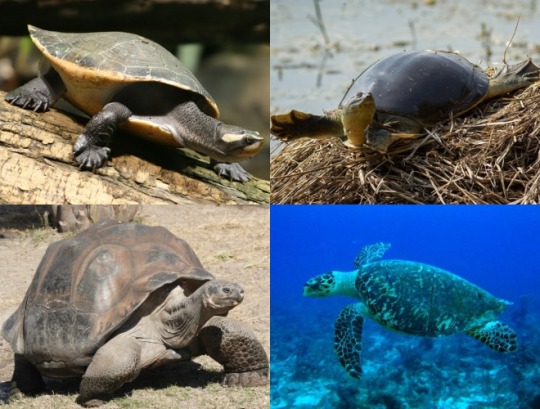
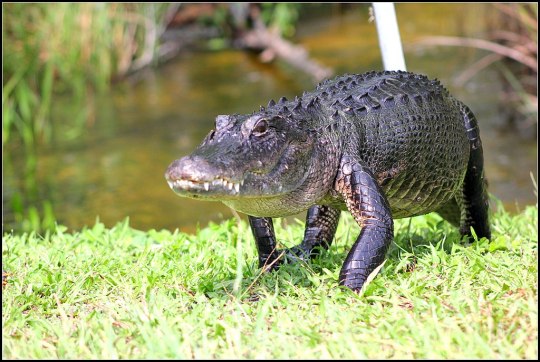
Pantestudines. This reptile order contains turtles and tortoises.
Crocodilia. This reptile order contains crocodiles and alligators
#animals#biology#polls#poll tournament#zoology#turtles#tortoises#reptiles#tetrapods#crocodiles#aligators#Pantestudines#Crocodilia#0x17v0xe8#Animal Tournament#Animal Tournament Round 1
78 notes
·
View notes
Text
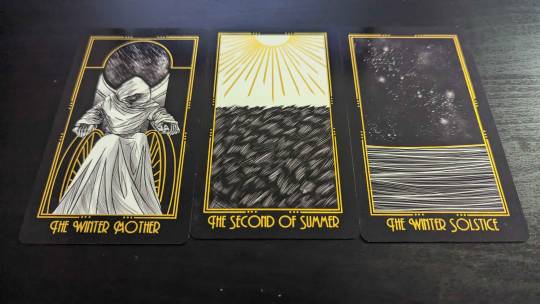
Thank you for the signup @pantestudines!
Old troubles unraveled, you will reach a period of calm. A re-centering.
67 notes
·
View notes
Text
nine people i want to get to know better!
tagged by @bi-ologie!! thank you! sorry this took several days to post, i am bad at writing things on work days ;-;
last song i listened to: sober to death- car seat headrest
currently watching: the new Shogun adaptation on fx
sweet/savory/spicy: savory > spicy > sweet!!
relationship status: single
current obsession: ive been very into learning more abt vinegaroons and amblys lately after deciding i Will have one lol, they're so unique and charming!! my mom and i are also raising plant puppies again for the outdoor garden so my entire life revolves around seedlings right now lmao. ALSO i am back on my dunmeshi bullshit now that the entire internet has fallen in love with it as much as i did like 2 years ago
five things you could talk about for an entire hour: how cool paleosols are and how they work, plant toxins/defenses, early mammal phylogeny/taxonomy (particularly ungulates), polar and mountaineering disasters and exploration, dispelling misinfo abt early humans/human ancestors
tagging (no pressure obviously!! only if you want to!) @ghostlament @pantestudines @oleworm @ratsf0rbrains @lithix @naiadpress @swallowtailed @lyrifaun @organicmatter
2 notes
·
View notes
Text

The Ocean Demon; Akiarus
The Akiarus are Leviathan type monster that lives in costal regions of the old and new world, it is a large aquatic reptile that occupies a niche different from other marine apexes, they arent apex predators and they are a bit common than most other predators, they eat different prey from others such as small fish, sharks shelled molusces and also scavenges meat on land, they have also been observed to work together as a pod to take down large preys such ass juvenile ceadeus, they also have a defense mechanism in the form of water beams these monsters can absorb water through their throat and stores them in a specialized sack next to their lungs and they can spit water soo hard it boils, these monsters sometimes disturbs local costal villages to steal their supplies of fish and many villagers are terrified of them and given the name The Ocean Demon!
Classification; Leviathan Order: Pantestudines Suborder; Eosauropterygia Superorder; Sauropterygia Family: Nothosauridae
Size; 40ft long Elements: Water Ailments: Waterblight Weakest To: Fire
You can leave your thoughts down here on the replies i would love to see what you all think of this monster i made that would be appreciating ^w^!
4 notes
·
View notes
Text
@pantestudines

Various chelonians. The life of vertebrates. 1962.
Internet Archive
2K notes
·
View notes
Text
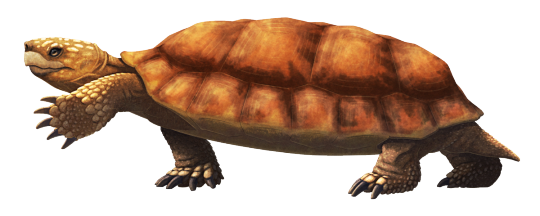
Jiangxichelys neimongolensis was a terrestrial turtle that was part of an extinct group known as nanhsiungchelyids, whose closest living relatives today are the aquatic softshell turtles.
(This species was previously known as "Zangerlia” neimongolensis, but has since been moved into the genus Jiangxichelys instead.)
It lived towards the end of the Cretaceous, about 75-71 million years ago, in what is now the Gobi Desert – which at the time was more of a semi-arid climate with both rivers and sand dunes.
Its 60cm long (~2') carapace had a long wide shape that made it appear rather flattened from the front, but not to quite as much an extreme as its larger American cousin Basilemys.
Several fairly well-preserved specimens have been found that appear to have been buried alive, probably either engulfed by sudden sandstorms or trapped in collapsing burrows. This has preserved some anatomical details previously unknown in nanhsiungchelyids, such as the pattern of scales on top of the head and the presence of large bony osteoderms on the underside of the front toes, which may have aided with traction on loose sandy ground.
———
NixIllustration.com | Tumblr | Patreon
References:
Brinkman, Donald, and Jiang-Hua Peng. "A new species of Zangerlia (Testudines: Nanhsiungchelyidae) from the Upper Cretaceous redbeds at Bayan Mandahu, Inner Mongolia, and the relationships of the genus." Canadian Journal of Earth Sciences 33.4 (1996): 526-540. https://doi.org/10.1139/e96-041
Brinkman, Donald B., et al. "New exceptionally well-preserved specimens of “Zangerlia” neimongolensis from Bayan Mandahu, Inner Mongolia, and their taxonomic significance." Comptes Rendus Palevol 14.6-7 (2015): 577-587. https://doi.org/10.1016/j.crpv.2014.12.005
Jerzykiewicz, T., et al. "Djadokhta Formation correlative strata in Chinese Inner Mongolia: an overview of the stratigraphy, sedimentary geology, and paleontology and comparisons with the type locality in the pre-Altai Gobi." Canadian Journal of Earth Sciences 30.10 (1993): 2180-2195. https://doi.org/10.1139/e93-190
Tong, Haiyan, and Lu Li. "A revision of the holotype of Nanhsiungchelys wuchingensis, Ye, 1966 (Testudines: Cryptodira: Trionychoidae: Nanhsiungchelyidae)." Cretaceous Research 95 (2019): 151-163. https://doi.org/10.1016/j.cretres.2018.11.003
Tong, Haiyan, et al. "New material of Jiangxichelys ganzhouensis Tong & Mo, 2010 (Testudines: Cryptodira: Nanhsiungchelyidae) and its phylogenetic and palaeogeographical implications." Geological Magazine 154.3 (2017): 456-464. https://doi.org/10.1017/S0016756816000108
Wikipedia contributors. “Nanhsiungchelyidae.” Wikipedia, 19 Nov. 2023, https://en.wikipedia.org/wiki/Nanhsiungchelyidae
#science illustration#paleontology#paleoart#palaeoblr#jiangxichelys#zangerlia#nanhsiungchelyidae#cryptodira#turtle#testudines#pantestudines#reptile#art#ancient mutant fossil turtles#turtle power
177 notes
·
View notes
Text
Sunday 6/6/21 - Your Dinosaurs Are Not Dinosaurs
Links to previous posts in this series:
Your Dinosaurs Are Wrong
Your Pterosaurs Are Wrong

Dimetrodon, Mark Witton
You know how when you're really into something, like a fandom or maybe a hobby, and you're like "I know outsiders to this thing won't know everything, but there's surely some information on my thing that's common knowledge", and then you're wrong? That's me after every time I make a Dinosaur post.
In the previous two blogposts I made about extinct giant reptiles, I explained the inconsistencies between scientific knowledge and common knowledge on how Dinosaurs and Pterosaurs actually looked. But it seems there's also a gap in the public's knowledge of what actually constitutes a Dinosaur.
The Mesozoic Period was an age between 252-66 million years ago, often called the Age of the Reptiles, and although Dinosaurs were definitely the dominant clade of animals on land then, other reptiles and reptile-adjacent animals were successful too. Today I'll enlighten readers on what non-dinosaur animal groups were successful during that age, and what they were actually related to.
Pterosaurs
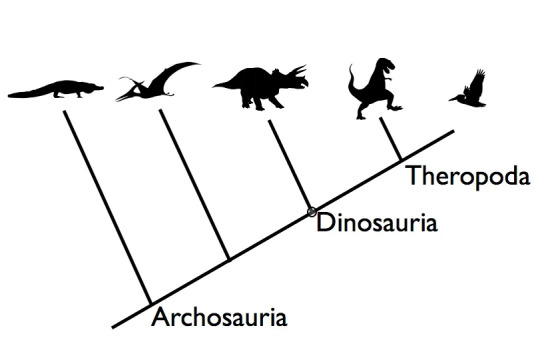
Cladogram of the evolutionary relationship of Archosaurs. Crocodilians diverged first, then Pterosaurs, before Dinosaurs.
I covered a lot about pterosaurs in a previous post, but just so it's covered in this post, let's talk about them again. Since writing that last post, I heard a good way to describe the relationship between Pterosaurs and Dinosaurs. With a lot of the animal groups covered in this post, it's like "No this is definitely not a dinosaur", but with Pterosaurs, it's more like "They're technically not a dinosaur", in the same way a rabbit is technically not a rodent. They're closely related sister groups, but they diverged long enough ago that scientists agree they're separate.

Pterodactylus antiquus, Mark Witton
As an aside, something I wanted to discuss in the Pterosaur post, is that a lot of people mistakenly use the name "Pterodactyl" to refer to all pterosaurs. There was no such animal named that. There was a species called Pterodactylus, but it is probably a smaller and less impressive Pterosaur than what you have in your head.
Synapsids
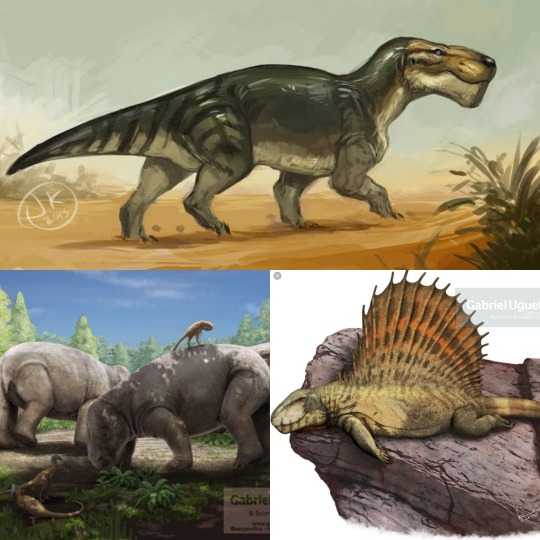
Top: Gorgonopsid, Jonathan Kuo
Bottom Left: Dicynodont, Gabriel Ugueto
Bottom Right: Dimetrodon, Gabriel Ugueto
In the early Mesozoic, when dinosaur's ancestors were all tiny and had yet to take over the world, a group of animals called Synapsids were the dominant force. Mammals eventually branched off from this group, so they're sometimes called stem-mammals or mammal-like reptiles. Dimetrodon, arguably the most commonly dinosaur-labelled non-dinosaur, was in this group. Others include the beak faced Dicynodonts, and the sabre toothed Gorgonopsids, which all look almost dinosaurian but they're not.
Pseudosuchia

A collection of Pseudosuchians, ColinM_Art on twitter
People often refer to Crocodilians as living dinosaurs (even though birds are the closest living relatives). Although it is true that the crocodile/alligator shape has persisted for millions of years, ancient relatives (collectively referred to as Pseudosuchia) experimented with lots of different forms. The very ferocious Postosuchus was an apex predator in the Triassic, and the suspiciously dinosaur-looking Desmatosuchus was an armoured herbivore, and many other Triassic relatives became bipedal predators like Poposaurus. Later in the Mesozoic, a lot of these more specialised crocodile relatives were replaced by more successful dinosaur counterparts, but the big aquatic ambush predator type still persists to this day.
Plesiosaurs

Top: Thalassiodracon, Mark Witton
Bottom: Liopleurodon, Kuzim Art
I sometimes see books or publications discuss "Aquatic Dinosaurs" or "Sea Dinosaurs", and most often they are talking about Plesiosaurs. Plesiosaurs were a member of flippered, streamline shaped reptiles with necks of varying length that specialised in hunting sea life. Scientists aren't certain of their origins, but most refer to them as Pantestudines, sharing a common ancestor with turtles and tortoises. Elasmosaurus and Liopleurodon are some of the more popular members of the group.
Icthyosaurs
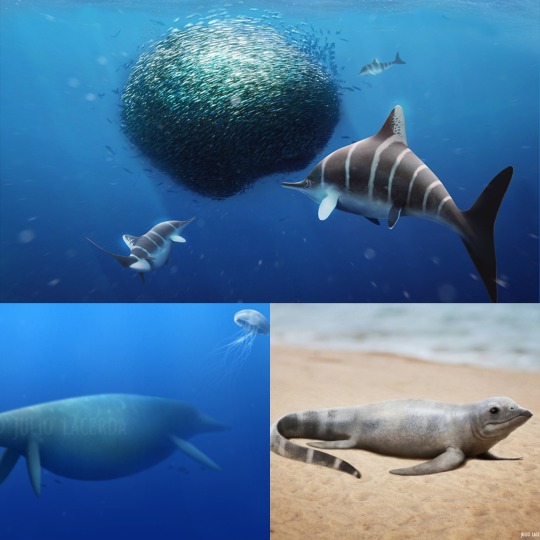
Top: Ichthyosaurus larkini
Bottom Left: Shonisaurus
Bottom Right: Cartorhynchus
(All 3 Arts done by Juilo Larceda)
Although less resembling a dinosaur shape, and therefore less often mistaken for one, Ichthyosaurs were another marine reptiles group that lived alongside them. Although early relatives were more reptile shaped, later ichthyosaurs developed a shark/dolphin body plan, and were the most aquatically agile marine reptiles. They could range in size from the dolphin sized Ophthalmosaurus to the whale sized Shonisaurus. They diverged from other reptiles groups very early, but some scientists think they share a common ancestor with lizards.
Mososaurs
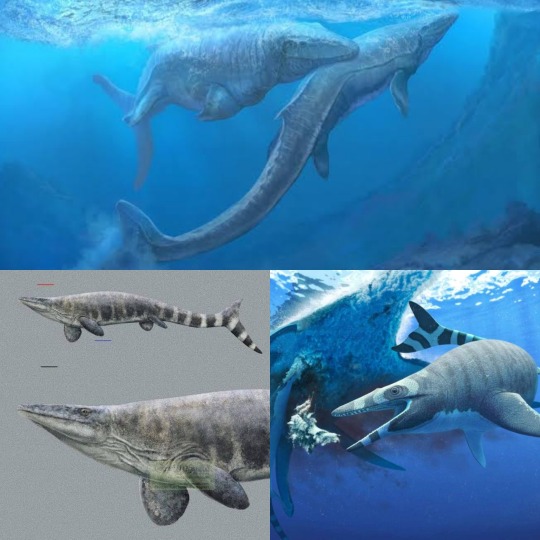
Top: Mososaurus, Mark Witton
Bottom Left: Tylosaurus, Gabriel Ugueto
Bottom Right: Xenodens, Andrey Atuchin
Mososaurs evolved much later than most of these other non-dinosaurs. They superficially resembled short-necked Plesiosaurs, but would have likely used their tail more than their flippers for propulsion. Mososaurs evolved from aquatic monitor lizards in the late Cretaceous, and quickly reached sizes bigger than any other lizard would ever reach. Mososaurus, which featured (much bigger than it was in life) in Jurassic World, is one of the best known species.
Thanks for Reading
Tumblr only allows so many pictures in one post, but I've covered most of the main groups of animals people mistakenly call dinosaurs. Just as a final titbit, someone recently told me that they thought the "-saur" or "-saurus" ending on many ancient animals automatically means dinosaur, but it is just Greek for reptile, and scientists slap it on the end of many scientific names, many of which aren't even reptiles, just may look like them.

As an example, Basilosaurus was actually found to be a Whale after its fossils were better studied. But it kept its name.
Source: The7thSea, DeviantArt
If there's more you'd like me to cover on the topic of dinosaurs, any of the other cool animals I've discussed here, or maybe other animals you're unsure are dinosaurs or not, leave a comment or send us a message.
Cheers for reading, and hope you learned something today.
#blog#blogpost#dinosaurs#mesozoic#extinct animals#pterosaurs#archosaurs#Crocodilians#pseudosuchia#therapsid#synapsid#plesiosaur#pliosaur#ichthyosaur#mososaur
191 notes
·
View notes
Text
Odontochelys semitestacea
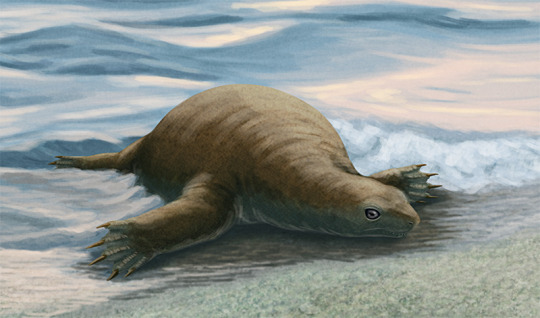
By @alphynix
Etymology: Toothed Turtle
First Described By: Lie et al., 2008
Classification: Biota, Archaea, Proteoarchaeota, Asgardarchaeota, Eukaryota, Neokaryota, Scotokaryota, Opimoda, Podiata, Amorphea, Obazoa, Opisthokonta, Holozoa, Filozoa, Choanozoa, Animalia, Eumetazoa, Parahoxozoa, Bilateria, Nephrozoa, Deuterostomia, Chordata, Olfactores, Vertebrata, Craniata, Gnathostomata, Eugnathostomata, Osteichthyes, Sarcopterygii, Rhipidistia, Tetrapodomorpha, Eotetrapodiformes, Elpistostegalia, Stegocephalia, Tetrapoda, Reptiliomorpha, Amniota, Sauropsida, Eureptilia, Romeriida, Diapsida, Neodiapsida, Sauria, Archosauromorpha?, Archelosauria, Pantestudines, Odontochelyidae
Time and Place: Around 232 million years ago, in the Carnian age of the Late Triassic
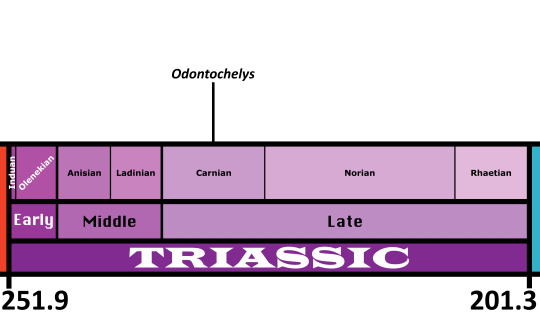
Odontochelys is known from the Lower Member of the Xiaowa Formation of China, commonly known as the Guanling Fauna
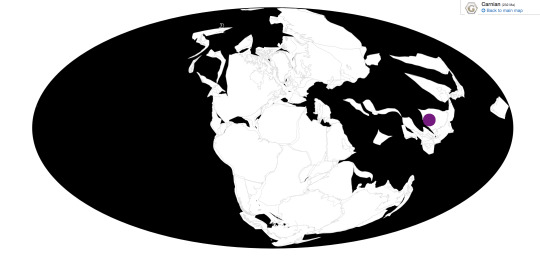
Physical Description: Odontochelys is one of the earliest known turtles - preceded by one, possibly two, precursors other than stem members of the family group - and it showcases how this extremely unique group managed to evolve in the chaos that was the Triassic Explosion. It was simultaneously similar to and very different from living turtles, a true transitional organism. Like other reptiles, it had teeth embedded in its jaws, rather than the toothless beak found in turtle mouths. Like turtles, it had the lower plastron extending from its ribs, but unlike living turtles it had no upper shell - instead, it just had widened ribs and no bony shell around its body. The ribs and the vertebrae were put together differently from modern turtles as well, and its skull was more stretched out compared to its living relatives. It didn’t have fused tail bones, and its scapulae were very different from living turtles. It had short limbs and long, thick fingers, as well as a decently sized shell. It was about forty centimeters long from snout to tail tip.
Diet: The diet of Odontochelys is fairly uncertain, despite us having its teeth; though they are small and peg like, we can’t really extrapolate a function since we don’t actually know its precise ecology! They may have been used for stripping plants, but it’s also possible they were used to chipp up algae and other aquatic water plants, or even invertebrates! So, more research there is clearly needed.
Behavior: The life history of Odontochelys is actually a big mystery. It was found in a marine environment, leading initial studies to indicate it was marine. However, it had the hands of a fresh water organism, including fresh water turtles today. Furthermore, studies of other early turtles indicate that turtles first arose on the land, rather than in the water, and later groups would adapt to water life; the limbs of Odontochelys share similarities with tortoises and support a terrestrial lifestyle. So, the ecology of Odontochelys has been a constant battle. That said, there is some evidence that it was actually marine - and may represent an early experiment in ocean life by turtles. One fossil of Odontochelys indicates that it had completely messed up shoulder bones, likely due to a problem in life rather than destruction of the fossil. This pattern resembles decompression sickness, aka the bends, aka the condition caused by a diving animal coming up much too fast from a lower depth. Modern turtles have complex behavioral adaptations to avoid the bends, so Odontochelys may be an early experiment in marine life in a group mostly adapted for terrestrial life. In this transition to ocean life, it not only lacked better physical adaptations for the ocean, but also better behavioral ones, and was stricken with the bends on its trip back to the surface. So, as we try to determine its ecology and behavior, these clued paint a rich tapestry of the world’s most transitional turtle. A pioneer!
Ecosystem: Odontochelys was found in - and thus, the null hypothesis is that it lived in - an ocean environment near the coast of the Tethys sea. This was a deep, open ocean - pelagic, hence the bends and problems Odontochelys faced trying to deal with the ocean. It was a very fertile ecosystem as well, with a variety of Triassic marine animals showcasing the rapid evolution of these groups. Among the invertebrates, there were many different types of Ammonites, plenty of bivalves, brachiopods, and crinoids & sea cucumbers as well. Still, the fascinating part of the ecosystem was the sheer number of marine reptiles. There were Thalattosaurs such as Anshusaurus and Xinpusaurus; Placodonts like Psephochelys and Sinocyamodus; and Ichthyosaurs like Qianicthyosaurus, Guizhouichthyosaurus, Guanlingsaurus, and Callawayia. One of many beautiful deposits of marine animals from this Period - and the many Ichthyosaurs would have been major predators of the relative n00b Odontochelys.
Other: Odontochelys also just looks really weird because it basically looks like your usual turtle except it doesn’t have a freaking shell so here we are with this oddity. It’s transitional in shape, transitional in ecology, transitional in behavior, and just. What the heck. What the heck, Odontochelys. If you need more proof for evolution despite knowing about the dinosaur - bird transition, have I got a friend for you.
~ By Meig Dickson
Sources Under the Cut
Anquetin, J. 2012. Reassessment of the phylogenetic interrelationships of basal turtles (Testudinata). Journal of Systematic Palaeontology 10(1):3-45.
Bradley Shaffer, H., E. McCartney-Melstad, T. J. Near, G. G. Mount, P. Q. Spinks. 2017. Phylogenomic analyses of 539 highly informative loci dates a fully resolved time tree for the major clades of living turtles (Testudines). Molecular Phylogenetics and Evolution 115: 7 - 15.
Feldmann, R. M., C. E. Schweitzer, S. Hu, J. Huang, Q. Zhang, C. Zhou, W. Wen, T. Xie, E. P. Maguire. 2017. A new Middle Triassic (Anisian) cyclidan crustacean from the Luoping Biota, Yunnan Province, China: morphologic and phylogenetic insights. Journal of Crustacean Biology 37 (4): 406 - 412.
Gilbert, S. F. 2007. How the turtle gets its shell. Biology of Turtles: The Structures to Strategies of Life.
Heiss, E. 2010. Functionality and plasticity of turtle-feeding with special emphasis on oropharyngeal structures. Universitat Wien Doctoral Dissertation.
Hess, H., W. Etter, and H. Hagdorn. 2016. Roveacrinida (Crinoidea) from Late Triassic (early Carnian) black shales of Southwest China. Swiss Journal of Paleontology 135(2):249-274.
Joyce, W. G. 2015. The origin of turtles: A paleontological perspective. Journal of Experimental Zoology Part B: Molecular and Developmental Evolution 324 (3): 181 - 193.
Lee, M. S. Y. 2013. Turtle origins: Insights from phylogenetic retrofitting and molecular scaffolds. Journal of Evolutionary Biology 26 (12): 2729 - 2738.
Lemell, P., N. Natchev, C. J. Beisser, E. Heiss. 2019. Feeding in Turtles: Understanding Terrestrial and Aquatic Feeding in a Diverse but Monophyletic Group. Feeding in Vertebrates: 611 - 642.
Li, C., and O. Rieppel. 2002. A new cyamodontid placodont from Triassic of Guizhou, China. Chinese Science Bulletin 47(5):403-407.
Li, C., X. C. Wu, O. Rieppel, L. T. Wang, and L. J. Zhao. 2008. An ancestral turtle from the Late Triassic of southwestern China. Nature 456:497-501.
Lu, H., D.-Y. Jiang, R. Motani, P.-G. Ni, Z.-Y. Sun, A. Tintori, S.-Z. Xiao, M. Zhou, C. Ji, W.-L. Fu. 2018. Middle Triassic Xingyi Fauna: Showing turnover of marine reptiles from coastal to oceanic environments. Palaeoworld 27 (1): 107 - 116.
Luo, M., Y.-M. Gong, G. R. Shi, Z.-Q. Chen, J. Huang, S. Hu, X. Feng, Q. Zhang, C. Zhou, W. Wen. 2018. Palaeoecological Analysis of Trace Fossil Sinusichnus sinuosus from the Middle Triassic Guanling Formationin Southwestern China. Journal of Earth Science 29: 854 - 863.
Meredith, R. W., J. Gatesy, M. S. Springer. Molecular decay of enamel matrix protein genes in turtles and other edentulous amniotes. BMC Evolutionary Biology 13: 20.
Neenan, J. M., N. Klein, T. M. Scheyer. 2013. European origin of placodont marine reptiles and the evolution of crushing dentition in Placodontia. Nature Communications 4: 1621.
Nicholls, E. L., C. Wei, and M. Manabe. 2002. New material of Qianichthyosaurus Li, 1999 (Reptilia, Ichthyosauria) from the Late Triassic of southern China, and implications for the distribution of Triassic icthyosaurs. Journal of Vertebrate Paleontology 22(4):759-765.
Reisz, R. R., J. J. Head. 2008. Palaeontology: Turtle origins out to sea. Nature 456 (7221): 450 - 451.
Rothschild, B. M., V. Naples. 2015. Decompression syndrome and diving behavior in Odontochelys, the first turtle. Acta Palaeontologica Polonica 60 (1): 163 - 167.
Schoch, R. R., H.-D. Sues. 2015. A Middle Triassic stem-turtle and the evolution of the turtle body plan. Nature 523 (7562): 584 - 587.
Shang, Q.-H., and C. Li. 2009. On the occurrence of the ichthyosaur Shastasaurus in the Guanling biota (Late Triassic), Guizhou, China. Vertebrata PalAsiatica 47(3):178-193.
Vermeij, G. J., R. Motani. 2017. Land to sea transitions in vertebrates: the dynamics of colonization. Paleobiology 44 (2): 237 - 250.
Wang, X., G. H. Bachmann, H. Hagdorn, P. M. Sanders, G. Cuny, X. Chen, C. Wang, L. Chen, L. Cheng, F. Meng, and G. Xu. 2008. The Late Triassic black shales of the Guanling area, Guizhou province, south-west China: a unique marine reptile and pelagic crinoid fossil lagerstätte. Palaeontology 51(1):27-61.
Wang, X., X. Chen, C. Wang, L. Cheng. 2009. The Triassic Guanling Fossil Group - A Key GeoPark from a barren mountain, Guizhou Province, China. Notebooks on Geology 3: Chapter 2: 11 - 28.
328 notes
·
View notes
Note
You forgot Scheyer et al. (2017), who put turtles & euryapsids progressively closer to saurians.
Uh, I included the results of four different analyses from Scheyer et al. (2017), including that of their preferred analysis (the one resulting in a four-way polytomy between Euryapsida, Pantestudines, Archosauromorpha, and Lepidosauromorpha).
They only recovered the topology you describe when they included a hypothetical outgroup coded as “0″ for all characters. That might have been a useful way to test the stability of their results, but it’s questionable whether the results can be directly compared to other studies that did not use the same procedure. As such, I chose not to include it in my selection.
0 notes
Text
I am having trouble tracking down what are considered synapomorphies of pantestudines (which may be so broad as to include sauropterygia) and/or stem-turtles. This is in part because the basal reptile fossils seem to be extremely inconclusive about their relationships, so nobody agrees what the synapomorphies are.
But regardless of diapsid/anapsid skulls, at least some other skull details appear to be involved in the definition. I don't understand them and won't quote them.
The earliest undisputed stem-turtles appear to have developed their belly ribs into plastrons before carapaces appeared, and eurhynchochelys seems to be headed along that line, at least.


Ancient Shell-Less Turtle Species Identified From 228-Million-Year-Old Triassic Era Fossil
Eorhynchochelys
(2018)
Scientists have discovered remains of a rare kind of turtle, one that lived over 228 million years ago in the Triassic era and had no shell – the most common feature of present-day turtles. The nearly complete skeleton of the ancient turtle was found by researchers from China's Institute of Vertebrate Paleontology and Paleoanthropology in the Asian country’s Guizhou province. The animal had a toothless beak and Frisbee-shaped body just like present-day turtles, but there were no signs of growing bones that form the shell. Modern turtles use the feature to enclose their vital organs, including the head in some cases, and protect themselves "This creature was over six feet long, it had a strange disc-like body and a long tail, and the anterior part of its jaws developed into this strange beak," Olivier Rieppel, one of the researchers involved in the work, said in a statement. "It probably lived in shallow water and dug in the mud for food." As no such turtle has been described in the books of science, the animal has been classified as a completely new species. It has been named Eorhynchochelys sinensis, which means the ‘Dawn turtle with a beak from China’...
Read more: Ancient Shell-Less Turtle Species Identified From 228-Million-Year-Old Triassic Era Fossil | IBTimes
388 notes
·
View notes
Note
Trick or Treat, can I have a cool rock?
Not my favorite rock, but I’ve got a rhyolite with manganese dendrites!
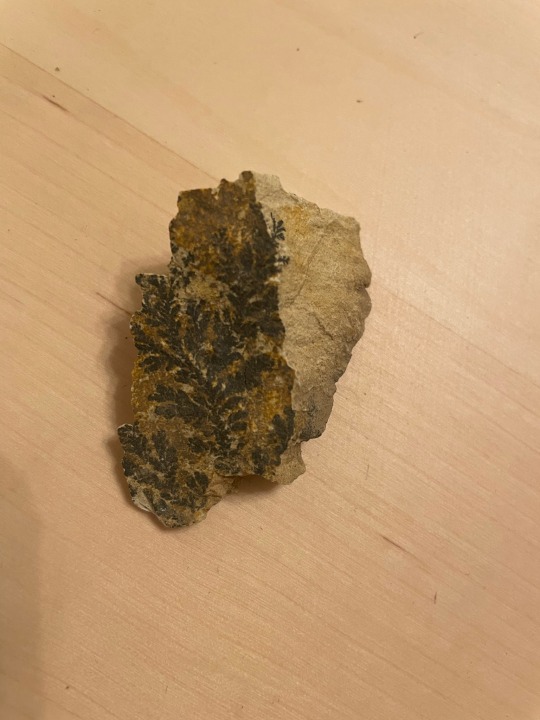
5 notes
·
View notes
Text
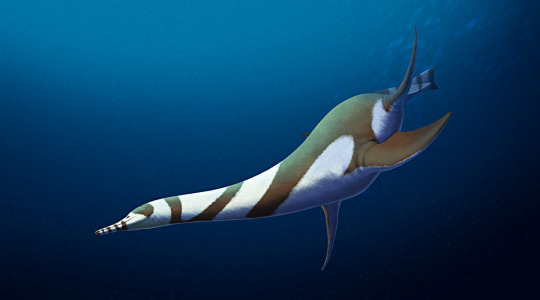
While the most iconic types of plesiosaur were long-necked with small heads and short blunt snouts, some of these marine reptiles actually developed the opposite sort of arrangement, with groups like the polycotylids and the pliosaurs independently evolving short necks, larger heads, and long snouts.
…Except some of them didn't keep it quite that simple.
Serpentisuchops pfisterae here lived during the late Cretaceous, about 70 million years ago, in the ancient Western Interior Seaway covering what is now Wyoming, USA. This 7m long (~23') plesiosaur was a member of the polycotylid lineage, but along with a long slender snout it also had an unusually long neck.
Some earlier polycotylids like Thililua had fairly long necks, too, but all of Serpentisuchops' closest relatives were short-necked species, so it seems to have actually re-evolved this condition rather than inheriting it from its ancestors. Since no other marine reptiles in its habitat had this particular body plan, it was probably occupying a very specific ecological niche – the presence of attachment points for powerful neck muscles suggest it was able to swing its head sideways to snap its jaws at prey at high speed, with its longer neck giving it more reach than other polycotylids.
———
NixIllustration.com | Tumblr | Twitter | Patreon
#science illustration#paleontology#paleoart#palaeoblr#serpentisuchops#polycotylidae#plesiosauria#plesiosaur#sauropterygia#pantestudines#marine reptile#art#long snout? or long neck?#both both is good
423 notes
·
View notes
Photo

Retro vs Modern #06: Plesiosaurus dolichodeirus
Plesiosaurs were first recognized as a distinct group of fossil animals in the early 1820s, only a few years after ichthyosaurs. Initially they were perceived as being closer in form to reptiles in the "chain of being" than the more fish-like ichthyosaurs were, and so the group's scientific name ended up reflecting that early interpretation – "plesiosaur" roughly translates to "near to reptiles".
The first named species of plesiosaur was Plesiosaurus dolichodeirus, based on a near-complete skeleton discovered by Mary Anning that revealed the strange long-necked proportions of these animals for the first time.
1830s-1850s
Early reconstructions of plesiosaurs in the 1830s compared them to "a snake threaded through a turtle", giving them highly sinuous necks and a turtle-like body. Much like ichthyosaurs they were assumed to be amphibious, using their flippers to crawl up onto the shore like a sea turtle.
The 1850s Crystal Palace plesiosaur statues show a variant of this design with smooth skin textures and fairly flexible reptilian bodies, with powerful shoulders and flipper postures that give them an overall almost seal-like appearance.
1860s-1990s
From the 1860s onwards a more upright S-shaped neck pose became the most common depiction of plesiosaurs. The writhing snake-like necks persisted in some reconstructions of the extremely long-necked elasmosaurids, but the overall design for these animals that caught hold for the next century was an egg-shaped body with oar-like flippers and a swan-like neck – a body plan that would end up so influential in pop culture that it was incorporated into modern lake monster folklore, with the Loch Ness Monster being the most famous example.
During this period plesiosaurs were often portrayed as floating or swimming at the water's surface, rowing along with their flippers and using their long necks to snatch up prey. They were generally assumed to still haul out turtle-style to lay their eggs on the shore, although it wasn't clear how the very largest species would have been able to support their own weight.
2020s
Since the 1990s a boom of new plesiosaur species and biomechanical studies have brought a lot of changes to our understanding of these marine reptiles.
Their necks are now considered to have been less flexible, capable only of more gentle curving, and were probably much thicker and more streamlined with the body than previously depicted. Rather than oar-like rowing all four of their flippers were probably used in more of an "underwater flying" vertical motion similar to modern sea turtles – which is pretty fitting, considering that their closest living relatives are now thought to actually be turtles.
They gave live birth and were probably warm-blooded, with a thick layer of insulating blubbery fat and a teardrop-shaped body outline. Their skin texture was smooth, but one exceptionally well-preserved specimen shows a covering of tiny thin millimeter-sized scales that wouldn't have been visible in life except in extreme closeup.
We now know Plesiosaurus itself was a fairly small species, around 3.5m long (~11'6"), with a broad body and a short thick tail that probably had a rudder-like fin – usually assumed to be vertically-oriented, but possibly horizontal instead. It lived during the Early Jurassic, about 201-183 million years ago, in the shallow tropical sea that covered what is now southern England, and had a rather small head compared to other plesiosaurs, with its eyes facing upwards and to the sides.
It had sharp needle-like teeth that would have been used to catch soft-bodied aquatic prey like fish and cephalopods. It's not known whether it had extensive fleshy lips, croc-like snaggletoothed jaws, or something in-between, so the facial soft tissue on this particular reconstruction is rather speculative.
———
Nix Illustration | Tumblr | Twitter | Patreon
#retro vs modern 2022#science illustration#paleontology#paleoart#palaeoblr#plesiosaurus#plesiosauridae#plesiosauria#sauropterygia#pantestudines#stem-turtles#archosauromorpha#reptile#art#retrosaurs#blubber#chub-blubs#also it gets lips because i'm sick of exposed teeth in plesiosaurs#now we know they were extensively blubbery having shrinkwrapped faces seems especially weird
3K notes
·
View notes
Text
@pantestudines

Ah thanks, I am not a hymenoptera person so I jut assumed that it was a gall wasp because it was laying eggs in the galls and I didn't know chalcidoid wasps did that but I will update the post
Gall wasp of some sort

14 notes
·
View notes
Photo
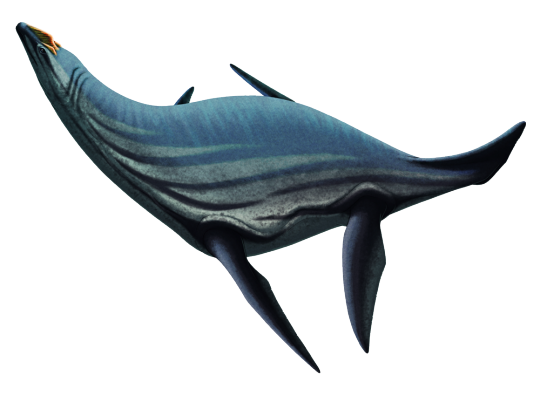
Umoonasaurus demoscyllus was a small short-necked plesiosaur, about 2m long (6'6"), that lived in the polar shallow seas covering much of what is now Australia 115 million years ago during the Early Cretaceous.
Its known fossil remains include a specimen nicknamed "Eric", one of the most complete opalized vertebrate skeletons ever found.
While most of its body was fairly generalized for a plesiosaur, its skull was unusually ornamented. A raised ridge along the middle of its snout shows evidence of supporting a larger keratinous crest, and smaller ridges over each of its eyes may have also had similar structures. These crests were fairly delicate so were probably mainly used for visual display, and might have been brightly colored.
———
Nix Illustration | Tumblr | Twitter | Patreon
#science illustration#paleontology#paleoart#palaeoblr#umoonasaurus#leptocleididae#plesiosaur#sauropterygia#pantestudines#marine reptile#art
791 notes
·
View notes